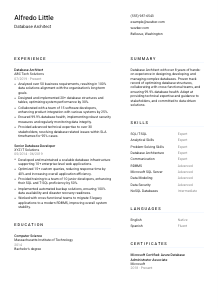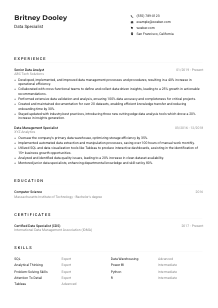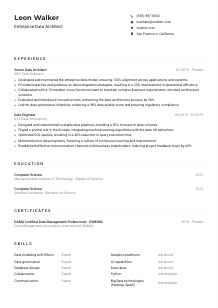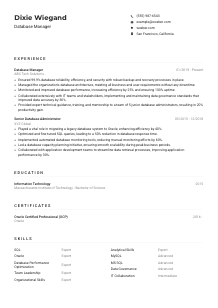Database Architect Resume Example
Building data blueprints, but your resume looks extracted from a flat file? Explore this Database Architect resume example, constructed with Wozber free resume builder. Discover how smoothly you can synchronize your schema skills with job requisites, crafting a career trajectory as efficient as an optimized query!

How to write a Database Architect Resume?
Embarking on crafting a Database Architect resume that not only stands out but seamlessly aligns with the desired job description? You're at the perfect starting line. Your resume is not just a piece of paper; it's a strategic artifact that reflects your professional essence.
Leveraging Wozber's free resume builder, this guide is tailor-made to navigate you through the creation of an ATS-compliant resume that resonates well with the essence of a Database Architect role. Let's transform your expertise into a compelling narrative that makes hiring managers sit up and take notice.
Personal Details
Kickstarting your resume with the Personal Details section might seem straightforward, yet it's your first handshake with potential employers. Here, we delve into how to customize this section so it sings in harmony with the Database Architect role, ensuring accuracy and strong alignment with job prerequisites.
1. Clearly Showcase Your Name
Think of your name as your brand. Highlight it using a clear, neat font, perhaps a tad larger than the rest of your document to ensure it stands out. Remember, this is the first detail hiring managers notice; make it memorable.
2. Job Title Precision
Directly below your name, insert the position you're vying for, "Database Architect" in this scenario. This mirrors your career aspiration and instantly informs the hiring manager of the role you're targeting. Consider this a strategic move to align your application with the employer's needs seamlessly.
3. Essential Contact Info
Under contact information, include a phone number and a professional email address (sth like firstname.lastname@email.com). Accuracy is key – a minor typo could mean a missed opportunity. This is also the place to state your current city and state, reflecting the local availability if specified in the job description.
4. Address Locality Requirement
By specifying "Bellevue, Washington" as your location, you align with one of the crucial requirements of being locally based for the role. It's a subtle yet effective way to tick an essential box right off the bat.
5. Optional Professional Profile
A LinkedIn profile or personal website showcasing your projects or portfolio could be a valuable addition. Ensure they are updated and mirror the professionalism of your resume. This is your online handshake – make it count.
6. Privacy First
Personal details like age, gender, or marital status aren't just irrelevant; they could inadvertently open doors to bias. Keep the focus on your professional capabilities and leave out what's unnecessary.
Takeaway
The Personal Details section is more than just an introductory passage; it's the first opportunity to align your application with the job's requirements. Paying attention to details here sets the tone for a professional and targeted resume. Let your introduction serve as a polished preamble to the narrative of your professional excellence.





Experience
The experience section is your storytelling platform where you bring to life your contributions as a Database Architect. It's here that you demonstrate how your past roles have prepared you for the position at hand. Following the steps below can help ensure your experience section resonates deeply with the job you're applying for.
- Analyzed over 50 business requirements, resulting in 100% data solutions alignment with the organization's long‑term goals.
- Designed and implemented 20+ database structures and tables, optimizing system performance by 30%.
- Collaborated with a team of 15 software developers, enhancing product integration with various systems by 25%.
- Ensured 99.9% database health, implementing robust security measures and regularly monitoring data integrity.
- Provided advanced technical expertise to over 30 stakeholders, resolving database‑related issues within SLA timeframes for 95% cases.
- Developed and maintained a scalable database infrastructure supporting 10+ enterprise‑level web applications.
- Optimized 15+ custom queries, reducing response time by 40% and increasing overall application efficiency.
- Provided training to a team of 10 junior developers, enhancing their SQL and T‑SQL proficiency by 50%.
- Implemented automated backup solutions, ensuring 100% data availability and disaster recovery readiness.
- Worked with cross‑functional teams to migrate 5 legacy applications to a modern RDBMS, improving overall system stability.
1. Dissect the Job Specifications
To start, dissect the job description carefully to grasp each requirement. Highlighting terms like "database design," "SQL/T-SQL," or "Microsoft SQL Server" will give you a clear direction on what experiences to spotlight.
2. Present Your Professional Timeline
Structure this section by listing your roles chronologically, putting your most recent position at the forefront. For each role, include your job title, the company's name, the duration of employment, and notably, your key accomplishments.
3. Narrate Your Achievements
Under each position, articulate your responsibilities and achievements that intersect with the job's demands. For instance, mentioning how you "Designed and implemented 20+ database structures, optimizing system performance by 30%" directly aligns with the job's responsibilities.
4. Quantify Your Impact
Numbers tell stories. Quantifying your achievements, as in "enhanced product integration with various systems by 25%," adds a tangible dimension to your accomplishments, making them more impactful.
5. Relevance is Key
While it might be tempting to list every achievement under the sun, focus primarily on those directly relevant to the role of a Database Architect. This targeted approach will prevent your resume from becoming a novel no one has the time to read.
Takeaway
Transform your experience section into a testament to your qualifications for the Database Architect role. Each entry is a story of your past achievements interwoven with the job's needs. Use precise, quantifiable achievements to paint a picture of a candidate who not just meets but exceeds expectations. Remember, you're the protagonist of this story; make every word count.
Education
While projecting straightforwardness, the Education section can subtly underscore your readiness for the Database Architect position. By weaving your educational background into the narrative, it reinforces your professional journey. Follow these tips to ensure this section contributes to your resume's cohesive story.
1. Identify Required Qualifications
Firstly, pinpoint the educational prerequisites from the job description – in our case, a "Bachelor's degree in Computer Science, Information Technology, or relevant field." Matching this verbatim on your resume is essential for ATS optimization and illustrates you meet the foundational criteria.
2. Structure with Clarity
Maintain a clear and concise layout for this section. List your degree, the field of study, the educational institution, and your graduation year. This transparency aids both ATS and human screeners in quickly assessing your qualifications.
3. Degree Details Matter
The exact naming of your degree is crucial, especially in fields like Computer Science, where specifics can significantly impact your resume's ATS optimization. Ensure that the degree listed mirrors the language found in the job description.
4. Relevant Courses or Projects
Especially for those early in their career or within a highly specialized role, listing relevant coursework or significant projects can underline your niche expertise. Though this wasn't needed for the example resume, it's a potent tool to remember.
5. Highlight Additional Achievements
If you've graduated with honors, led a relevant student organization, or worked on significant projects, mention these if they align with the Database Architect role. Such details can add dimensions to your academic background, especially for entry or mid-level roles.
Takeaway
Your Education section is a canvas to portray not just your academic qualifications but a reflection of your dedication and foundation for a Database Architect role. By carefully aligning this section with job requirements, it serves as a reinforcing pillar, elevating your resume's overall narrative.
Certificates
In the ever-evolving tech landscape, certifications act as badges of honor, showcasing your commitment to staying at the forefront of database technologies. This section is particularly crucial for a Database Architect, emphasizing continuous learning and expertise in specialized areas.
1. Decipher the Job's Calls for Certifications
Although the job description didn't explicitly require certifications, including relevant ones, like "Microsoft Certified: Azure Database Administrator Associate," can tremendously boost your resume. It signifies a dedication to honing your craft and staying updated with industry standards.
2. Select Pertinent Certificates
Choose to list certifications that are most relevant to the job. This is not about showcasing every certificate you've ever earned but about strategically selecting those that bolster your candidacy for the Database Architect role.
3. Be Clear About Dates
Including the acquisition or expiration dates of your certifications can be informative, especially in a fast-paced field like database architecture. It demonstrates your current knowledge and proficiency levels.
4. Pursue Continuous Learning
The tech field is dynamic, with new developments surfacing regularly. Actively seeking out certifications in emerging database technologies or methodologies demonstrates a proactive approach to professional growth and a commitment to excellence.
Takeaway
Your certificates are a testament to your dedication to professional development and expertise in the Database Architect realm. Curating this section with strategic selections speaks volumes about your readiness and eagerness to excel in this role.
Skills
The skills section serves as a quick-reference index of your professional toolkit. For a Database Architect, showcasing a mix of technical proficiencies and soft skills is imperative. Here's how to make this section a beacon of your suitability for the role.
1. Extract from Job Description
Start by meticulously going through the job posting, underlining both the explicit and implicit skills required. SQL/T-SQL, problem-solving, and effective communication are skills directly pulled from our job description, making them prime candidates for this section.
2. Match and Showcase
For each skill identified from the job description, mirror it with your competencies. Being precise and strategic about the skills you list ensures the hiring manager sees you as a fit. Wozber's ATS resume scanner can be invaluable here, helping ensure your chosen skills align with ATS requirements.
3. Organize for Impact
Resist the temptation to clutter this section with every skill under the sun. Focusing on key skills relevant to a Database Architect role makes for a cleaner, more impactful read. Balance hard skills like RDBMS proficiency with soft skills like analytical thinking for a well-rounded profile.
Takeaway
The Skills section is your professional highlight reel, showcasing the technical and soft skills that make you an exceptional Database Architect candidate. Curate this section with precision, choosing each skill for its relevance and impact, ensuring you present yourself as the perfect fit for the role.
Languages
In our interconnected world, the ability to communicate across languages can be a valuable asset. For a Database Architect, especially in diverse or global companies, showcasing linguistic skills can add another dimension to your candidacy.
1. Benchmark Against Job Requirements
Start with the job requirements. If a specific language, like English, is emphasized as a "key skill," make sure it's prominently featured in your resume, reflecting your fluency and aligning with the requirement.
2. Rank According to Relevance
Position the required or most relevant language at the top of your list, clearly indicating your proficiency level. This hierarchy signals to employers that you are well-equipped to communicate effectively in their primary business language.
3. Showcase Additional Languages
Even if additional languages aren't specified in the job description, listing them can underline your versatility and readiness to engage in diverse or international settings.
4. Accurately Assess Your Proficiency
Be honest and clear about your language proficiency levels, using terms like "Native," "Fluent," "Intermediate," or "Basic." This transparency ensures realistic expectations about your communication abilities in different languages.
5. Contextualize Your Language Skills
For roles that entail collaboration across regions or with international stakeholders, your multilingual capabilities can be especially appealing. If this is applicable, emphasizing your language skills could give you an edge.
Takeaway
Your linguistic abilities symbolize more than words on a page; they reflect your capacity to navigate and connect in a global professional environment. Tailoring this section to the job's requirements while honestly appraising your proficiency paves the way for opportunities beyond borders.
Summary
A well-crafted summary can significantly elevate your resume, offering a powerful snapshot of your professional journey. For a Database Architect, this section must succinctly articulate your expertise, experience, and the unique value you bring to the role.
1. Grasp the Job Essence
Initiate with a deep dive into the job specifications. Understanding the core of what makes a Database Architect indispensable to an organization will guide you in tailoring your summary to speak directly to those needs.
2. Start with a Strong Introduction
Open your summary with a concise statement that encapsulates your professional identity and your experience years, such as, "Database Architect with over 8 years of hands-on experience in designing, developing, and managing complex databases."
3. Highlight Your Unique Offerings
Delve into a few of your most pertinent skills and achievements that align with the job description. This is where you illustrate your direct impact on past projects and roles, demonstrating your capability to deliver similarly impressive results in the future.
4. Keep It Snappy
While brevity is key, ensure your summary is packed with information that resonates with the hiring manager. Think of it as your professional pitch; make every word count to grab attention and set the stage for the rest of your resume.
Takeaway
Your summary is the headline of your professional story, offering a glimpse into your career and what you can offer as a Database Architect. Tailor it to echo the job's requirements while highlighting your unique qualities and accomplishments. This powerful opener can be the difference that captures the hiring manager's interest.
Launching Your Database Architect Journey
Congratulations, you've now got a blueprint for a Database Architect resume that is attuned to the nuances of your desired role. Armed with insights from this guide, coupled with Wozber's free resume builder and ATS resume scanner, you're well-equipped to craft a compelling resume. Your professional story is unique, and with these tips, you can fine-tune your presentation to not just meet but exceed the expectations of your future employer. The path to becoming a standout Database Architect is clear; it's time to embark on this exciting journey with confidence.

- Bachelor's degree in Computer Science, Information Technology, or relevant field.
- Minimum of 8 years of experience in database design, development, and management.
- In-depth knowledge of data modeling, database architecture, and SQL/T-SQL.
- Proficiency with relational database management systems (RDBMS), particularly Microsoft SQL Server.
- Strong analytical and problem-solving skills with the ability to work collaboratively in a team environment.
- The ability to communicate effectively in English is a key skill.
- Must be located in Bellevue, Washington.
- Analyze business requirements, assess database feasibility, and ensure data solutions meet organization's long-term goals.
- Design and implement database structures, tables, indexes, and custom queries to optimize system performance.
- Collaborate with software developers, data architects, and IT teams to ensure integration with various systems across the organization.
- Monitor and maintain database health, security, backups, and data integrity on a regular basis.
- Provide technical expertise, guidance, and support to both internal and external stakeholders on database-related matters.















